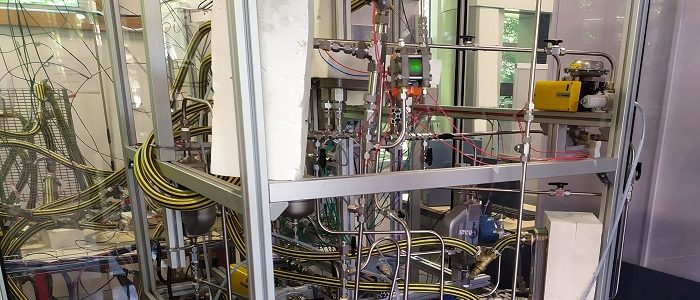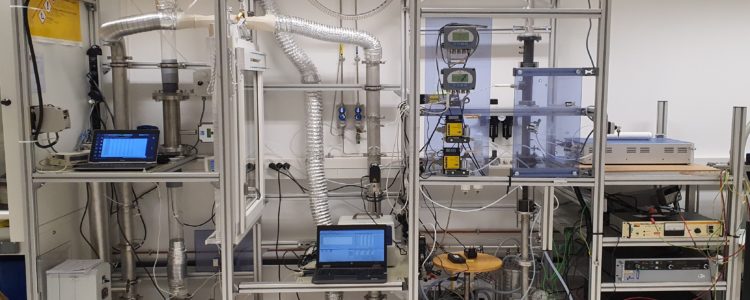Scientific orientations
L’objectif général de ce thème est de comprendre et de maitriser la physique de procédés innovants dédiés à une intégration au sein de bâtiments durables. Pour ce faire, les études menées au sein du thème STEP vise à modéliser leur comportement, évaluer leurs efficacités en conditions contrôlées et in situ, et optimiser leurs paramètres opératoires en fonction des conditions environnementales et des besoins.
Les procédés concernés sont les procédés énergétiques à absorption et adsorption pour la valorisation de chaleur basse température renouvelable ou de récupération, les échangeurs de chaleur et de matière couplés (échangeurs à film tombant), les systèmes de stockage par chaleur sensible (eau, sol), latente et par sorption, les capteurs solaires thermiques, les cheminées solaires, les capteurs hybrides, les arbres solaires, les procédés de transformation et de conversion de l’énergie dans le bâtiment, les procédés de traitement de l’air (adsorption, électrofiltration, ionisation).
Un des enjeux particulièrement abordé est de concevoir des systèmes ayant le moins d’impact environnemental possible, en mettant en œuvre des procédés robustes dont les coûts énergétiques sont minimisés, ou pour les procédés d’oxydation par exemple, en concevant des procédés acceptables en termes de sous-produits ou d’intermédiaires réactionnels. Au-delà du procédé même, l’intégration dans le bâtiment et son environnement demeurent un verrou scientifique (en lien avec le thème SITE), notamment pour étudier les transferts de polluants extérieur/intérieur (bâtiments), pour apprécier le ratio entre bénéfice sanitaire et coût énergétique des systèmes d’épuration ou pour étudier la chaîne de transformation énergétique solaire thermique, à l’échelle de chaque composant (capteur, stockage, diffuseur, pompe à chaleur à sorption…) et à l’échelle de leur couplage.
Les méthodes mises en œuvre dans ce thème sont, d’une part, les expérimentations en conditions contrôlées et in situ et, d’autre part, la modélisation phénoménologique, les analyses thermodynamiques, les méthodes asymptotiques et l’optimisation (approche thermodynamique, algorithme génétique etc).
Objectifs scientifiques spécifiques
Un des objectifs est l’amélioration des performances des machines trithermes à absorption, utilisées dans différents modes de fonctionnement (production de froid, de chaleur, de travail, stockage d’énergie thermique, ou fonctionnement hybride), par une approche multi-échelle. La modélisation numérique et thermodynamique sera réalisée aux trois échelles des procédés : la caractérisation des phénomènes locaux hydrodynamiques, massiques, thermiques et thermochimiques dans les films tombant à sorption ; leur mise en œuvre efficace dans des échangeurs de sorption ; l’intégration de ces composants dans des procédés innovants. Un enjeu qui sera abordé pour l’intégration de ces machines dans les bâtiments solaires est la modélisation en régime variable à ces différentes échelles. A l’échelle du film, l’enjeu est de comprendre les couplages entre transferts et instabilités hydrodynamiques, par le développement de modèles mathématiques simples et robustes permettant une analyse fine des phénomènes et des simulations 3D statistiquement résolues à l’échelle d’un élément d’échangeur. A l’échelle d’un échangeur, des lois de dimensionnement robustes et validées expérimentalement doivent être obtenues.
Un second objectif est l’optimisation de la production solaire et du stockage sensible ou latent. Le développement du solaire dans les bâtiments de type NZEB (Nearly Zero Energy Buildings) nécessite de maximiser à la fois la production solaire (chaleur et électricité) et le rendement de stockage en lien avec l’intermittence de la ressource et le besoin des usagers. Les problématiques scientifiques associées relèvent d’une part de l’étude des phénomènes de transferts de masse / chaleur et de photo-conversion. Les méthodologies développées reposent sur l’analyse dimensionnelle, la modélisation des phénomènes isolés (CFD, rayonnement, changement de phase) et l’étude expérimentale en condition contrôlée (PIV, éclairage artificiel). D’autre part, il s’agit de caractériser et d’optimiser les performances des composants et systèmes développés. La modélisation porte sur des phénomènes couplés (système complet), et les tests de prototypes pouvant être réalisés en conditions contrôlées ou réelles.
Un troisième objectif est de contribuer au développement de méthodes et d’outils pour l’évaluation et la prédiction des performances des absorbants pour le traitement de micropolluants et pour le stockage d’énergie. Les travaux de modélisation engagés ces dernières années seront étendus à des études de sensibilité et l’utilisation d’analyses dimensionnelles. Ces études doivent permettre de justifier le choix des modèles les plus adaptés. L’ensemble de ces outils pourra être étudié pour nos cas limites, c’est-à-dire pour de faibles concentrations en adsorbat et/ou de très fortes compétitions entre composés (eau-polluant).
Responsables du thème
- Michel ONDARTS
- Anne-Laure PERRIER
| Name | First name | Status | Mail (@univ-smb.fr) |
| AGBOSSOU | Amen | Professor | Amen-Edem.AGBOSSOU |
| CHHAY | Marx | MCF | marx.chhay |
| FRAISSE | Gilles | Professor | gilles.fraisse |
| GOLLY | Benjamin | MCF | benjamin.golly |
| GONZE | Evelyne | Professor | evelyne.gonze |
| THE STONES | Nolwenn | Professor | nolwenn.le-pierres |
| MENEZO | Christophe | Professor | christophe.menezo |
| MERLIN | Gérard | Professor Emeritus | gerard.merlin |
| ONDARTS | Michel | MCF | michel.ondarts |
| PAILHA | Mickael | MCF | mickael.pailha |
| PERRIER | Anne-Laure | MCF | anne-laure.perrier |
| RAMOUSSE | Julien | MCF HDR | julien.ramousse |
| RUYER-QUIL | Christian | Professor | christian.Ruyer |
| SOUYRI | Bernard | MCF | bernard.souyri |
| STUTZ | Benoit | Professor | benoit.stutz |

Projets et collaborations
En lien avec l’objectif « machines à absorption », nous maintenons les collaborations avec le laboratoire L2ST (Laboratoire des Systèmes Solaire et Thermodynamique) du CEA-INES, ainsi qu’avec des laboratoires de la HES-SO en Suisse (Lesbat, LTE…). Par ailleurs, nous participons activement au GDR Transinter. Une plateforme de caractérisation des échangeurs de chaleur et de masse à film tombant en conditions contrôlées est en cours de finalisation et devrait être entièrement fonctionnelle pour 2021-2025.
Concernant l’objectif « adsorbants performants », les collaborations existantes avec les laboratoires spécialisés en synthèse et caractérisation de matériaux adsorbants (LCME USMB, IS2M UHA, LMI UCBL, LMCPA UPHF, IPRA UPPA) et les moyens expérimentaux développés au sein du laboratoires (bancs d’essais pour la caractérisation en dynamique des adsorbants, analyse thermogravimétrique) sont mis à profit dans de nombreux projets de recherche (ANR, projet Carnot, etc.). Un effort particulier est envisagé pour consolider les dispositifs permettant la mesure de micropolluants.
Concernant le stockage par matériaux à changement de phase, les collaborations existantes avec les laboratoires académiques (LaTEP et LGcGe) et d’autres partenaires (CEA, DATE, SMCI) seront poursuivies. Des actions vont être entamées sur les problématiques combinées du séchage solaire et de capteurs hybrides PVT.
Enfin, un projet ANR (WINFIL) démarre sur la problématique de la maîtrise conjointe de la qualité de l’air intérieur, du confort et des consommations énergétiques dans les bâtiments résidentiels et tertiaires. Ce projet, mené en partenariat avec le LaSiE, vise à mettre au point et à caractériser la performance d’une fenêtre pariéto-dynamique de nouvelle génération dotée d’un module de filtration électrostatique des particules.
Des exemples de projet en cours: le projet ANTEA ou le projet CONICS!
